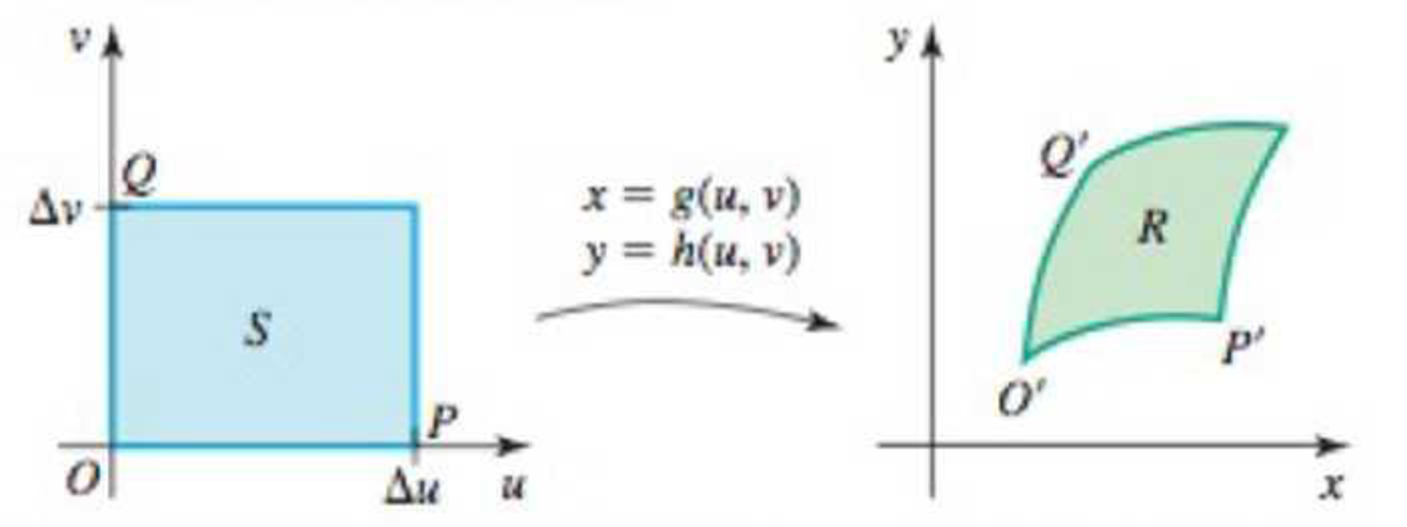
Concept explainers
Meaning of the Jacobian The Jacobian is a magnification (or reduction) factor that relates the area of a small region near the point (u, v) to the area of the image of that region near the point (x,y).
a. Suppose S is a rectangle in the uv-plane with vertices O(0,0), P(Δu, 0), {Δu, Δv), and Q(0, Δv) (see figure). The image of S under the transformation x = g(u, v), y = h(u, v) is a region R in the xy-plane. Let O’ P’ and Q’ be the images of O, P, and Q, respectively, in the xy-plane, where O’ P’ and Q’ do not all lie on the same line. Explain why the coordinates of O’, P’, and Q’ are (g(0, 0), h(0, 0)), (g(Δu, 0), h(Δu, 0)), and (g(0, Δv), h(0, Δv)), respectively.
b. Use a Taylor series in both variables to show that
where gu (0,0) is
c. Consider the
d. Explain why the ratio of the area of R to the area of S is approximately |J(u, v)|.

Want to see the full answer?
Check out a sample textbook solution
Chapter 16 Solutions
CALCULUS: EARLY TRANSCENDENTALS (LCPO)
Additional Math Textbook Solutions
College Algebra (7th Edition)
A Problem Solving Approach To Mathematics For Elementary School Teachers (13th Edition)
College Algebra with Modeling & Visualization (5th Edition)
Pre-Algebra Student Edition
Algebra and Trigonometry (6th Edition)
Calculus: Early Transcendentals (2nd Edition)
- 3. Use the method of washers to find the volume of the solid that is obtained when the region between the graphs f(x) = √√2 and g(x) = secx over the interval ≤x≤ is rotated about the x-axis.arrow_forward4. Use cylindrical shells to find the volume of the solid generated when the region enclosed by the given curves is revolved about the x-axis. y = √√x, y = 0, y = √√3arrow_forward5 4 3 21 N -5-4-3-2 -1 -2 -3 -4 1 2 3 4 5 -5+ Write an equation for the function graphed above y =arrow_forward
- 6 5 4 3 2 1 -5 -4-3-2-1 1 5 6 -1 23 -2 -3 -4 -5 The graph above is a transformation of the function f(x) = |x| Write an equation for the function graphed above g(x) =arrow_forwardThe graph of y x² is shown on the grid. Graph y = = (x+3)² – 1. +10+ 69 8 7 5 4 9 432 6. 7 8 9 10 1 10 -9 -8 -7 -6 -5 -4 -3 -2 -1 1 2 3 4 5 -2 -3 -4 -5 -6- Clear All Draw:arrow_forwardSketch a graph of f(x) = 2(x − 2)² − 3 4 3 2 1 5 ས་ -5 -4 -3 -2 -1 1 2 3 4 -1 -2 -3 -4 -5+ Clear All Draw:arrow_forward
- 5. Find the arc length of the curve y = 3x³/2 from x = 0 to x = 4.arrow_forward-6 -5 * 10 8 6 4 2 -2 -1 -2 1 2 3 4 5 6 -6 -8 -10- The function graphed above is: Concave up on the interval(s) Concave down on the interval(s) There is an inflection point at:arrow_forward6 5 4 3 2 1 -6 -5 -3 -2 3 -1 -2 -3 -4 -5 The graph above is a transformation of the function x² Write an equation for the function graphed above g(x) =arrow_forward
- 6 5 4 3 2 1 -1 -1 -2 -3 -4 A -5 -6- The graph above shows the function f(x). The graph below shows g(x). 6 5 4 3 2 1 3 -1 -2 -3 -4 -5 -6 | g(x) is a transformation of f(x) where g(x) = Af(Bx) where: A = B =arrow_forward5+ 4 3 2 1. -B -2 -1 1 4 5 -1 -2 -3 -4 -5 Complete an equation for the function graphed above y =arrow_forward60 फं + 2 T 2 -2 -3 2 4 5 6 The graph above shows the function f(x). The graph below shows g(x). फ 3 -1 -2 2 g(x) is a transformation of f(x) where g(x) = Af(Bx) where: A = B =arrow_forward
- Algebra & Trigonometry with Analytic GeometryAlgebraISBN:9781133382119Author:SwokowskiPublisher:Cengage
 Elementary Geometry For College Students, 7eGeometryISBN:9781337614085Author:Alexander, Daniel C.; Koeberlein, Geralyn M.Publisher:Cengage,
Elementary Geometry For College Students, 7eGeometryISBN:9781337614085Author:Alexander, Daniel C.; Koeberlein, Geralyn M.Publisher:Cengage,

